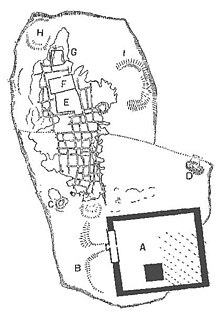Inaros I.
Inaros I ( ancient Egyptian Iarau, Iret-Heru , eye of Horus , also Irpai, Iripat ; ancient Greek Ίνάρως) is the Greek name of the ancient Egyptian prince of Kemwer , the middle of the seventh century BC. Around 667 BC Ruled.
Contemporary evidence
Inaros I was the son of Bakennefi III. and grandson of Petubastis II (Padiaset). His name “[…] arau”, which was initially only partially preserved, has now been safely identified by Kim Ryholt and others in connection with the Carlsberg manuscripts . For example, the oath of loyalty to the city god Chentechtai is documented. In addition, the temple of Athribis is known from the mentions of his campaigns. In Assyrian inscriptions under Assurbanipal next to Bakennefi III. a "[...] -ḫi / arau" called, whose name comes very close to the late Egyptian pronunciation "yincharau" ( the eye of Horus ), thus also the Greek name "Inaros".
In Assyrian personal name lists, the name of a court official is also documented, which, as a probable Assyrian equation, Nicharau corresponds to the late Egyptian yincharau . In other Assyrian sources, the Egyptian spelling occurs in Assyrian implementation, so that due to the narrow time horizon in Egyptology, several contemporary documents of the Inaros are assumed.
Inaros I is part of the revolts against the Assyrian rule in connection with Necho I , Tanotamun and Pekrur von Pisope . His deeds were used as a novel motif in the story The battle for the armor of Inaros . There Inaros is buried in Busiris after his death . Further archaeological campaigns may be able to clarify whether this indication of the narrative comes close to reality.
Inaros and Strabons chronology
According to the ancient historian Strabo , Inaros was defeated by the Milesians during the reign of Psammetich , who are said to have been responsible for founding the city of Naukratis at around the same time . Excavations have shown that the first traces of settlement in Naukratis due to ceramic finds in the second third of the seventh century BC. Are to be determined. Strabo further explains that that Psammetich was a contemporary of Kyaxares .
Overall, Strabo's chronological information regarding Inaros I largely coincides with the actual occurrences, although the laying of the foundation stone by Naukratis in the reign of Psammetich I was not carried out until a few decades later and other small chronological uncertainties regarding Strabo's statements remain.
See also
literature
- Friedhelm Hoffmann , Joachim Friedrich Quack : Anthology of demotic literature (= introductions and source texts on Egyptology. Volume 4). LIT, Berlin 2007, ISBN 3-8258-0762-2 .
- Joachim Friedrich Quack: The demotic and Graeco-Egyptian literature . LIT, Münster 2005, ISBN 3-8258-8222-5 .
- Joachim Friedrich Quack: Inaros, hero of Athribis . In: Robert Rollinger : Antiquity and the Mediterranean: The ancient world on this side and beyond the Levant (Festschrift for Peter W. Haider on his 60th birthday) . Steiner, Stuttgart 2006, ISBN 3-5150-8738-9 , pp. 499-506.
- Kim Ryholt: The Petese Stories II (The Carlsberg papyri 6) . Museum Tusculanum Press, Copenhagen 2006, ISBN 8-7635-0404-9 .
| personal data | |
|---|---|
| SURNAME | Inaros I. |
| ALTERNATIVE NAMES | Iarau; Iret-Heru; Iripat; Irpai |
| BRIEF DESCRIPTION | Ruler of Kemwer |
| DATE OF BIRTH | 7th century BC Chr. |
| DATE OF DEATH | 7th century BC Chr. |
